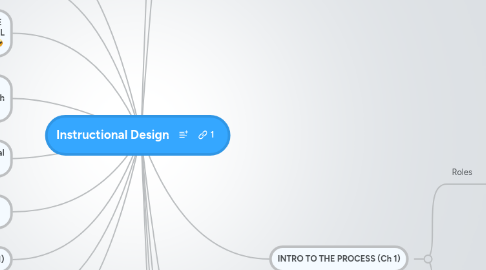
1. INSTRUCTIONAL STRATEGIES (Ch 7)
1.1. Generative Strategies
1.1.1. Recall
1.1.2. Integration
1.1.3. Organizational
1.1.4. Elaboration
2. Gagne Resources (Week 8)
2.1. Conditions of Learning
2.1.1. Nine Events of Instruction
2.1.1.1. 1. Gaining attention
2.1.1.2. 2. Informing Learners of the Objective
2.1.1.3. 3. Stimulating Recall of Prior Learning
2.1.1.4. 4. Presenting the Stimulus
2.1.1.5. 5. Providing Learning Guidance
2.1.1.6. 6. Eliciting Performance
2.1.1.7. 7. Providing Feedback
2.1.1.8. 8. Assessing Performance
2.1.1.9. 9. Enhancing Retention and Transfer
2.1.2. 5 Categories of Learning Outcomes
3. DESIGNING THE INSTRUCTIONAL MESSAGE (Ch 8)
3.1. Preinstructional Strategies
3.1.1. Pretest
3.1.2. Behavioral objectives
3.1.3. Overview
3.1.4. Advance organizer
4. LEARNING THEORY AND INSTRUCTIONAL THEORY (Ch 14)
4.1. Learning Theory
4.1.1. Instructional Theory
4.1.2. Instructional Design Model
4.1.3. Types of Learning Theory
4.1.3.1. Behavioral Learning Theory
4.1.3.1.1. Social Leaning Theory
4.1.3.2. Cognitive Theory
5. Developing Instructional Materials (Ch 9)
5.1. Cognitive Load
5.1.1. Intrinsic Load
5.1.2. Extrinsic Load
5.1.2.1. Goal-Free Effect
5.1.2.2. Worked-Example Effect
5.1.2.3. Split-Attention Effect
5.1.2.4. Redundancy
6. Mayer's Principles (Ch 10)
6.1. 1. Coherence Principle
6.2. 2. Signaling Principle
6.3. 3. Redundancy Principle
6.4. 4. Spatial Contiguity Principle
6.5. 5. Temporal Contiguity Principle
6.6. 6. Segmenting Principle
6.7. 7. Pre-Training Principle
6.8. 8. Modality Principle
6.9. 9. Personalization Principle
6.10. 10. Voice Principle
7. EVALUATION (Ch 11)
7.1. Three types of evaluation
7.1.1. Formative Evaluation
7.1.2. Summative Evaluation
7.1.3. Confirmative Evaluation
7.2. Standards of Achievement
7.2.1. Relative
7.2.2. Absolute
7.3. necessary qualities
7.3.1. Validity
7.3.2. Reliability
8. IMPLEMENTATION (Ch 15)
8.1. Planned Change
8.1.1. Innovation
8.1.1.1. CLER Model
8.1.1.1.1. Adoption
8.1.1.1.2. Diffusion
8.1.1.2. CBAM
9. INSTRUCTIONAL DESIGN(Ch 16)
9.1. Project Management
9.1.1. Scope
9.1.1.1. Project Agreement
9.1.1.2. Legal Considerations
10. focuses on the learner
11. INSTRUCTIONAL OBJECTIVES (Ch 5)
11.1. Cognitive Domain
11.1.1. Cognitive Domain Resource (Week 6)
11.1.1.1. Creating
11.1.1.1.1. #1 at top of Bloom's Taxonomy Pyramid
11.1.1.2. Evaluating
11.1.1.2.1. #2 from top of Bloom's Taxonomy Pyramid
11.1.1.3. Analyzing
11.1.1.3.1. #3 from top of Bloom's Taxonomy Pyramid
11.1.1.4. Applying
11.1.1.4.1. #4 from top of Bloom's Taxonomy Pyramid
11.1.1.5. Understanding
11.1.1.5.1. #5 from top of Bloom's Taxonomy Pyramid
11.1.1.6. Remembering
11.1.1.6.1. # 6 from top; lowest level of Bloom's Taxonomy Pyramid
11.1.2. Bloom's Taxonomy
11.1.2.1. 6 levels in the cognitive domain from lowest to highest=Knowledge,Comprehension, Application, Analysis, Synthesis, Evaluation
11.1.2.1.1. Knowledge
11.1.2.1.2. Comprehension
11.1.2.1.3. Application
11.1.2.1.4. Analysis
11.1.2.1.5. Synthesis
11.1.2.1.6. Evaluation
11.2. Psychomotor Domain
11.2.1. Psychomotor Domain Resource (Week 6)
11.2.1.1. Dave's model
11.2.1.1.1. Imitate, Manipulate, Precision, Articulation, Naturalization
11.2.1.2. Simpson's model
11.2.1.2.1. Perception, Set, Guided response, Mechanism, Complex overt response, Adaptation, Origination
11.2.1.3. Harrow's model
11.2.1.3.1. Reflex movement, Basic-fundamental movements, Perceptual abilities, Physical abilities, Skilled movements, Nondiscursive communication
11.2.2. physical activities, levels of objectives=Imitation, Manipulation, Precision, Articulation
11.2.2.1. Imitation
11.2.2.2. Manipulation
11.2.2.3. Precision
11.2.2.4. Articulation
11.2.2.5. Naturalization
11.3. Affective Domain
11.3.1. Affective Domain Resource (Week 6)
11.3.1.1. Theories of Attitude Formation and Change
11.3.1.1.1. Behavioral Learning Theory
11.3.1.1.2. Cognitive Dissonance Theory
11.3.1.1.3. Affective-Cognitive Consistency
11.3.1.1.4. Social Judgment Theories
11.3.1.1.5. Social Learning Theory
11.3.1.1.6. Functional Theories
11.3.1.1.7. Krathwohl's Taxonomy
11.3.2. 5 levels=Receiving, Responding, Valuing, Organizing, Characterizing
11.3.2.1. Receiving
11.3.2.2. Responding
11.3.2.3. Valuing
11.3.2.4. Organizing
11.3.2.5. Characterizing by a value complex
12. INTRO TO THE PROCESS (Ch 1)
12.1. Roles
12.1.1. Instructional Designer
12.1.1.1. planner, coordinator, and manager with primary responsibility for designing the intruction
12.1.2. SME
12.1.2.1. Subject-Matter Expert is the content and resource expert
12.1.3. Evaluator
12.1.3.1. instruments for pre and post testing, gathering and interpreting data, and determining the effectiveness and efficiency of the program
12.2. Design Model
12.2.1. Instructional Problem
12.2.1.1. need for instruction
12.2.2. Learners
12.2.2.1. target audience
12.2.3. ADDIE
12.2.3.1. Analysis Design Development Implementation and Evaluation
12.2.4. Methods
12.2.4.1. process
12.2.5. Objectives
12.2.5.1. focal point
12.2.6. Evaluation
12.2.6.1. assessment
13. IDENTIFYING THE NEED (Ch 2)
13.1. Needs Assessment
13.1.1. 1. Normative Needs
13.1.1.1. compares target to norm or standard
13.1.2. 2. Comparative Needs
13.1.2.1. compares target to a peer group
13.1.3. 3. Felt Needs
13.1.3.1. desire to improve
13.1.4. 4. Expressed Needs
13.1.4.1. felt need turned into action
13.1.5. 5. Anticipated Needs
13.1.5.1. identifying future changes
13.1.6. 6. Critical Incident Needs
13.1.6.1. analyzing potential problems
13.2. Goal Analysis
13.2.1. "defining the undefinable", set priorities
13.3. Performance Assessment
13.3.1. Identify the performance problem
14. TASK ANALYSIS (Ch 4)
14.1. Task Analysis
14.1.1. determination of needs and goals
14.2. Topic Analysis
14.2.1. identifies the content and the structure
14.2.2. Content Structures
14.2.2.1. Facts, Concepts, Principles and Rules, Procedures, Interpersonal Skills, and Attitudes
14.3. Procedural Analysis
14.3.1. Identify the steps to complete the learning task
15. SEQUENCING (Ch 6)
15.1. Elaboration Theory Sequencing
15.1.1. Content Expertise Sequencing
15.1.1.1. conceptual or theoretical
15.1.2. Task Experience Sequencing
15.1.2.1. simplifying conditions method
15.1.3. distiguishes between the types of expertise to be developed
15.2. (POSNER AND STRIKE SEQUENCING SCHEMES)
15.2.1. Concept-Related Sequencing
15.2.1.1. Class relations, Propositional releations, Sophistication, Logical prerequisite
15.2.2. World-Related Sequencing
15.2.2.1. Spatial Relations
15.2.2.1.1. physical layout
15.2.2.2. Temporal Relations
15.2.2.2.1. timeline
15.2.2.3. Physical Attributes
15.2.2.3.1. (appearance, characteristics)
15.2.3. Learning-Related Sequencing
15.2.3.1. 5 Student Learning Concepts
15.2.3.1.1. Identifiable prerequisite, Familiarity, Difficulty, Interest, Development
16. Learner Characteristics
16.1. Tessmer & Richey Article (Week 4)
16.1.1. Contextual Levels (3)
16.1.1.1. Orienting Context
16.1.1.2. Instructional Context
16.1.1.3. Transfer Context
16.1.2. Contextual Factors
16.1.2.1. Learner Factors
16.1.2.2. Immediate Environment Factors
16.1.2.3. Organizational Factors
16.2. LEARNER AND CONTEXTUAL ANALYSIS (Ch 3)
16.2.1. Learner Analysis
16.2.1.1. Characteristics, different traits
16.2.2. Contextual Analysis
16.2.2.1. Orienting Context
16.2.2.2. Instructional Context
16.2.2.2.1. environmental consideration
16.2.2.3. Transfer Context
16.2.2.3.1. continuing to apply knowledge and skills learned
